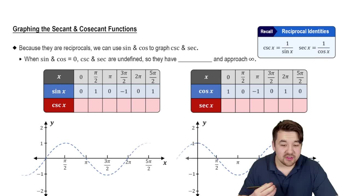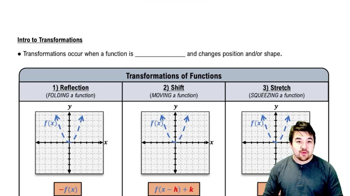Beginning with the graphs of or , use shifting and scaling transformations to sketch the graph of the following functions. Use a graphing utility to check your work.
Table of contents
- 0. Functions7h 54m
- Introduction to Functions16m
- Piecewise Functions10m
- Properties of Functions9m
- Common Functions1h 8m
- Transformations5m
- Combining Functions27m
- Exponent rules32m
- Exponential Functions28m
- Logarithmic Functions24m
- Properties of Logarithms36m
- Exponential & Logarithmic Equations35m
- Introduction to Trigonometric Functions38m
- Graphs of Trigonometric Functions44m
- Trigonometric Identities47m
- Inverse Trigonometric Functions48m
- 1. Limits and Continuity2h 2m
- 2. Intro to Derivatives1h 33m
- 3. Techniques of Differentiation3h 18m
- 4. Applications of Derivatives2h 38m
- 5. Graphical Applications of Derivatives6h 2m
- 6. Derivatives of Inverse, Exponential, & Logarithmic Functions2h 37m
- 7. Antiderivatives & Indefinite Integrals1h 26m
- 8. Definite Integrals4h 44m
- 9. Graphical Applications of Integrals2h 27m
- 10. Physics Applications of Integrals 3h 16m
- 11. Integrals of Inverse, Exponential, & Logarithmic Functions2h 31m
- 12. Techniques of Integration7h 41m
- 13. Intro to Differential Equations2h 55m
- 14. Sequences & Series5h 36m
- 15. Power Series2h 19m
- 16. Parametric Equations & Polar Coordinates7h 58m
0. Functions
Graphs of Trigonometric Functions
Problem 14
Textbook Question
Graph the functions in Exercises 13–22. What is the period of each function?
sin (x/2)
 Verified step by step guidance
Verified step by step guidance1
Identify the function: The function given is \( \sin(\frac{x}{2}) \). This is a sine function with a modified argument.
Determine the period of the sine function: The standard period of \( \sin(x) \) is \( 2\pi \). For \( \sin(\frac{x}{2}) \), the period is affected by the coefficient of \( x \) inside the sine function.
Calculate the new period: The period of \( \sin(kx) \) is \( \frac{2\pi}{|k|} \). Here, \( k = \frac{1}{2} \), so the period is \( \frac{2\pi}{\frac{1}{2}} = 4\pi \).
Graph the function: Start by plotting the key points of the sine function over one period \([0, 4\pi]\). These points include the intercepts, maximum, and minimum values.
Label the graph: Clearly indicate the period on the x-axis, and mark the amplitude (which remains 1 for this function) on the y-axis. The graph should show the wave completing one full cycle over the interval \([0, 4\pi]\).
 Verified video answer for a similar problem:
Verified video answer for a similar problem:This video solution was recommended by our tutors as helpful for the problem above
Video duration:
8mPlay a video:
Was this helpful?
Key Concepts
Here are the essential concepts you must grasp in order to answer the question correctly.
Period of a Function
The period of a function is the length of the interval over which the function repeats itself. For trigonometric functions like sine and cosine, the period is a key characteristic that determines how often the wave pattern occurs. For example, the standard sine function, sin(x), has a period of 2π, meaning it repeats every 2π units along the x-axis.
Recommended video:

Graphs of Secant and Cosecant Functions
Transformation of Functions
Transformations involve changes to the basic form of a function, such as stretching, compressing, or shifting. In the case of sin(x/2), the 'x/2' indicates a horizontal stretch, which affects the period. Specifically, dividing the input by a factor (like 2) increases the period, resulting in a new period of 4π for sin(x/2).
Recommended video:

Intro to Transformations
Graphing Trigonometric Functions
Graphing trigonometric functions requires understanding their key features, including amplitude, period, and phase shift. For sin(x/2), the graph will oscillate between -1 and 1, with a period of 4π, meaning it will complete one full cycle over this interval. Recognizing these features helps in accurately sketching the function and predicting its behavior.
Recommended video:

Introduction to Trigonometric Functions

 5:53m
5:53mWatch next
Master Graph of Sine and Cosine Function with a bite sized video explanation from Patrick
Start learningRelated Videos
Related Practice
Textbook Question
